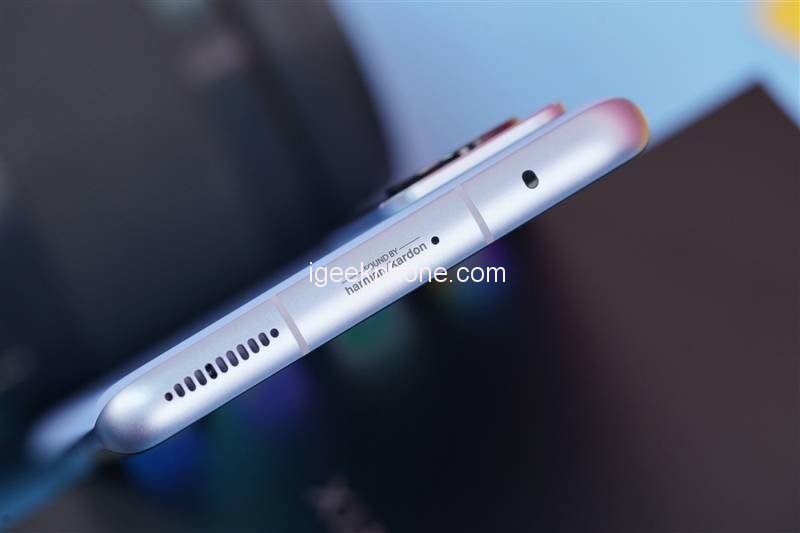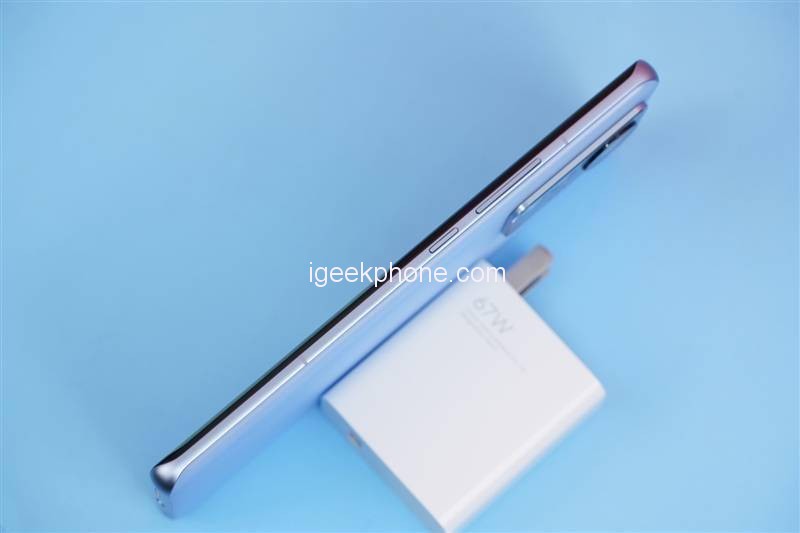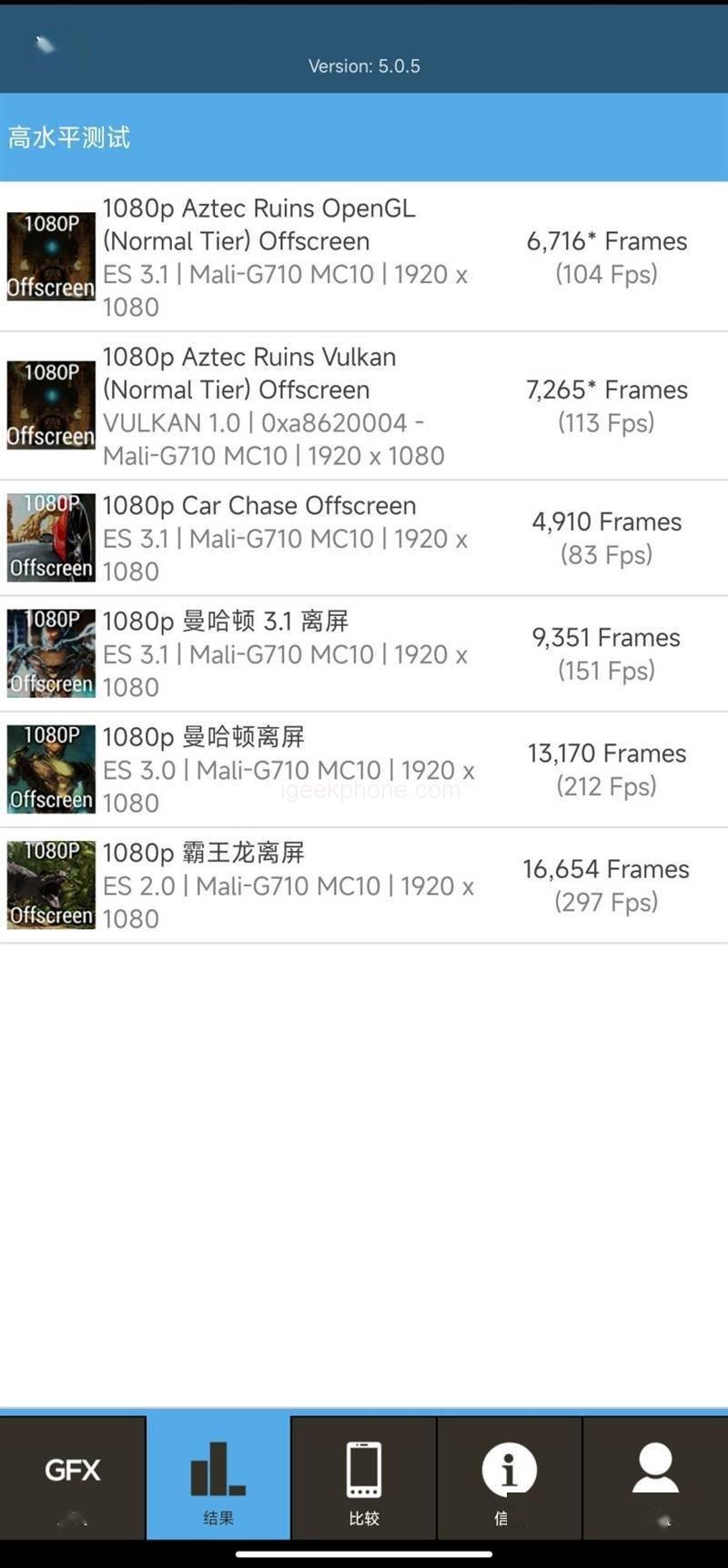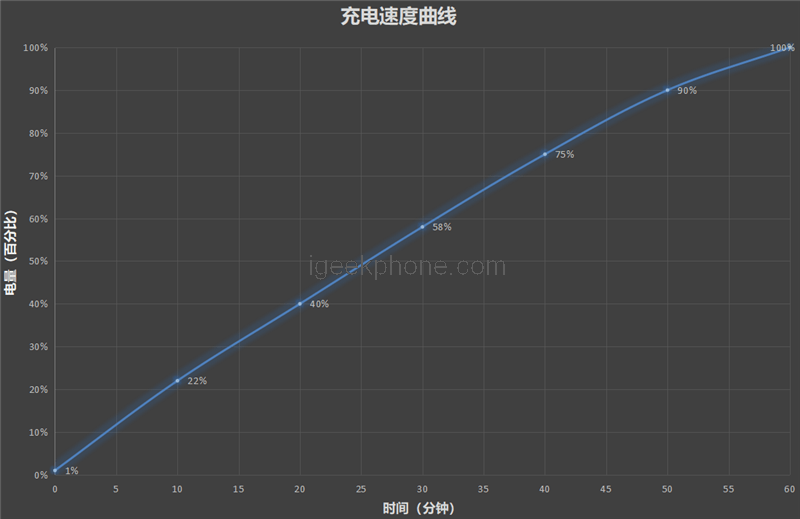The second half of 2022 has just begun, and it is time for phone manufacturers to make efforts. Xiaomi is taking the lead, not only bringing the Mi 12S series but also the Mi 12 Pro Dimensity Edition, the world’s first Dimensity 9000+ processor, This is also the first time that a Xiaomi brand mobile phone has used the Dimensity 9000 series platform. How does the top flagship of MediaTek adjusted by Xiaomi perform? Today, Fast Technology will find out with you. Compared with Xiaomi Mi 12 Pro, the main changes of this Mi 12 Pro Dimensity Edition are as follows: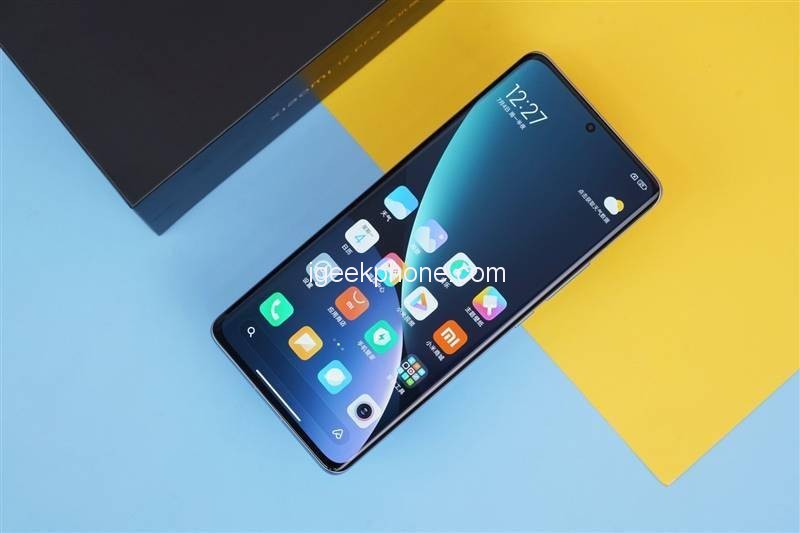
1. The first Dimensity 9000+
The specifications of Dimensity 9000+ are familiar to everyone. Based on TSMC’s 4nm process, it not only brings higher yield and heat dissipation performance, but also the CPU frequency has been improved compared with the previous generation, and the Cortex-X2 ultra-large core has been increased to 3.2 GHz, there are 3 2.85GHz Cortex-A710 medium cores and 4 1.8GHz Cortex-A510 small cores, the GPU uses the ten-core Mali-G710, and the performance is claimed to be 10% higher than that of the Dimensity 9000. The frequency is higher.
Coupled with 8MB of L3 cache and 6MB of system cache, the comprehensive capabilities of Dimensity 9000+ can be said to be completed ahead compared to Samsung’s 4nm Snapdragon 8, and it is expected to compete with TSMC’s 4nm upgraded version of Snapdragon 8+.
2. Battery and charging
The Xiaomi Mi 12 Pro supports 120W wired fast charging, 50W wireless charging, and 10W wireless recoil. The Mi 12 Pro Dimensity version only has a maximum of 67W wired charging, which has cut off wireless charging and wireless reverse charging.
However, the battery capacity has been increased from 4600mAh to 5160mAh. In addition, it also has a built-in Xiaomi self-developed charging chip Surging P1, which can greatly reduce energy loss and improve charging efficiency. The full charge speed is still considerable.
3. Inheritance of the main camera, a downgrade of the sub-camera
In terms of imaging, the Mi 12 Pro Dimensity Edition uses the same main camera as the Mi 12 Pro. The Sony IMX707 sensor has up to 50 million pixels, and the single-pixel size can reach 1.22% u3BCm. It also has four-axis OIS optical image stabilization.
There is also a 13-megapixel ultra-wide-angle lens and a 5-megapixel macro lens, which have also shrunk compared to the dual 50-megapixel ultra-wide-angle and telephoto lenses of the Mi 12 Pro.
4. Audio
The Harman Kardon-certified symmetrical four speakers featured on the Mi 12 Pro are also missing on the Mi 12 Pro Dimensity Edition, and become Harman Kardon dual speakers, which are still sufficient, but not as stunning as before.
In other respects, the 6.73-inch 2K 120Hz high refresh screen, full-blooded version of LPDDR5 memory and UFS 3.1 storage, VC liquid cooling, and 32-megapixel front camera have all been inherited.
It is worth mentioning that some time ago, the first OPPO Find X5 Pro Dimensity version equipped with the Dimensity 9000 chip was postponed due to the problem of image tuning. So how is the first image performance of the Xiaomi Mi 12 Pro Dimensity version?
In the next test, we will give the answers one by one.
The detailed specifications of the Xiaomi Mi 12 Pro Dimensity Edition are as follows:
Design & Appearance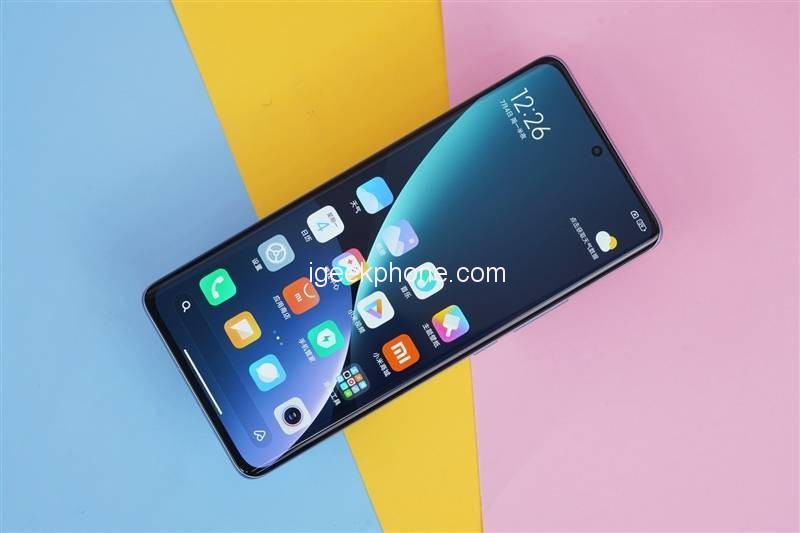
The front of the Mi 12 Pro Dimensity Edition uses a 6.73-inch Samsung E5 AMOLED screen with a resolution of 3200휔40 and an equivalent PPI of 425. The side frame is about 2.23mm, and the upper and lower borders are about 7.71mm. With the design of the hyperboloid screen, the overall visual and grip of the phone are very comfortable.
JNCD≈0.23, Delta E≈0.32, it can be seen that the screen tuning of Xiaomi Mi 12 Pro Dimensity Edition is quite good, and its color accuracy has reached the top flagship level.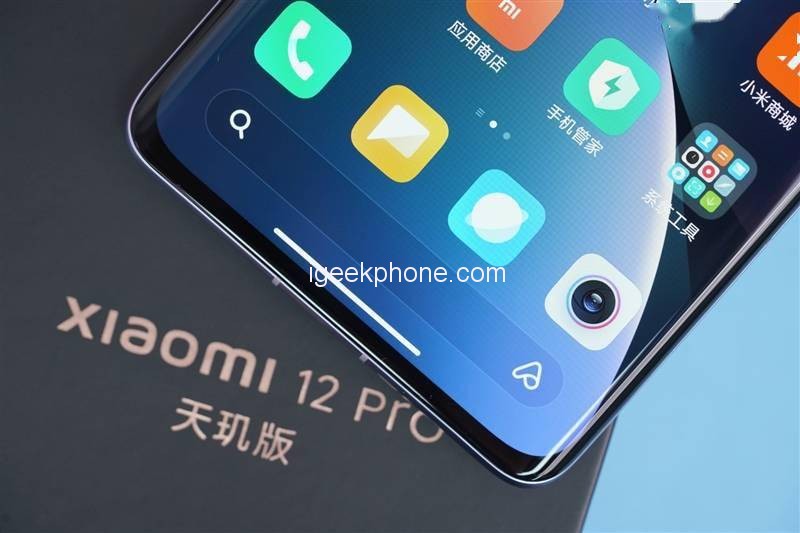
With the blessing of LTPO 2.0, the screen achieves adaptive display refresh rate performance and intelligently changes the refresh rate according to different usage scenarios. When the screen is still, the screen will run at a low refresh rate of 1Hz, which greatly saves the power consumption of the screen.
In the middle of the front of the fuselage, there is a 32-megapixel front camera opening. The handset of the phone has a micro-slit design that is barely visible from the front. The width of the chin at the bottom of the phone can be controlled, and the overall field of view of the screen is wider.
The back of the Mi 12 Pro Dimensity Edition uses the same glass back cover as the Mi 12, which is made by the self-developed AG etching process. The Mi 12 Pro Dimensity Edition we received is the blue version, and the matte texture on the back has a lovely feeling.
The rear three-camera module still adopts the family-style design elements of the Xiaomi Mi 12 series. The main camera uses a 50-megapixel Sony IMX707 CMOS, and the two sub-cameras below are a 13-megapixel ultra-wide-angle and a 5-megapixel telephoto micro-camera. From the lens, there are two dual-color temperature flashes on the right, with the word “50MP” below the flash.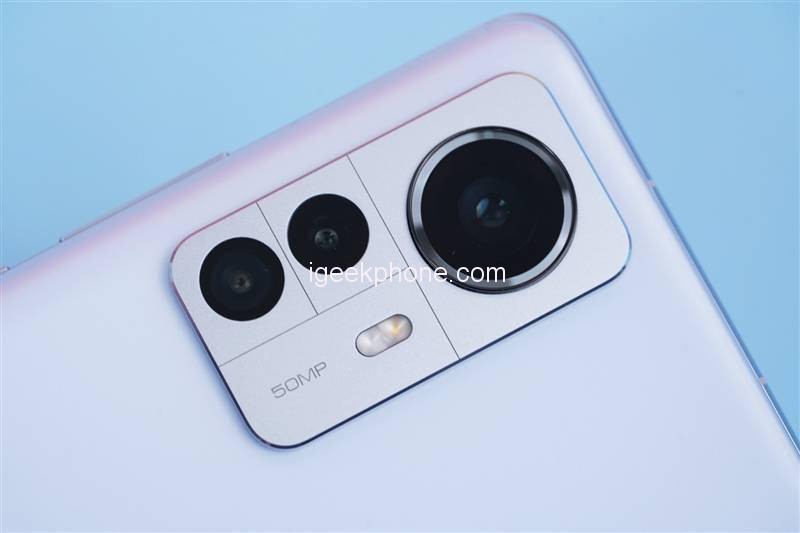
The side of the mobile phone is made of aluminum alloy middle frame material, the volume adjustment button and the power button are located on the right side of the fuselage, and there are two antenna strips on the upper and lower sides.
In terms of interfaces, there are speaker openings at the top and bottom of the Mi 12 Pro Dimensity Edition to form symmetrical dual stereo speakers.
The top is equipped with a noise-canceling microphone and an infrared remote control sensor, as well as the certification mark of Harman Kardon. The Type-C interface at the bottom of the phone is shared with the headphone port, and the right side is followed by the microphone opening and the SIM card slot.
In addition, the accessories section also provides a transparent protective case for the mobile phone, a card removal pin, a 67W fast charging adapter, and a data cable.
Performance
In the Dimensity 9000+ processor launched by the Xiaomi Mi 12 Pro Dimensity Edition, the CPU’s Cortex-X2 large-core frequency is increased from 3.05GHz of the Dimensity 9000 to 3.2GHz, the mid-core and small-core remain unchanged, and the GPU is still 10-core Mali-G710.
In theory, the overall performance of the Dimensity 9000+ has not improved much, but the main frequency of the large core has been upgraded. Therefore, the perception should not be large in daily use and gaming experience.
However, thanks to TSMC’s 4nm mature technology, the temperature control performance and energy efficiency ratio of mobile phones are still worth looking forward to.
Through several theoretical tests, let’s take a look at the specific performance improvement.
1. AnTuTu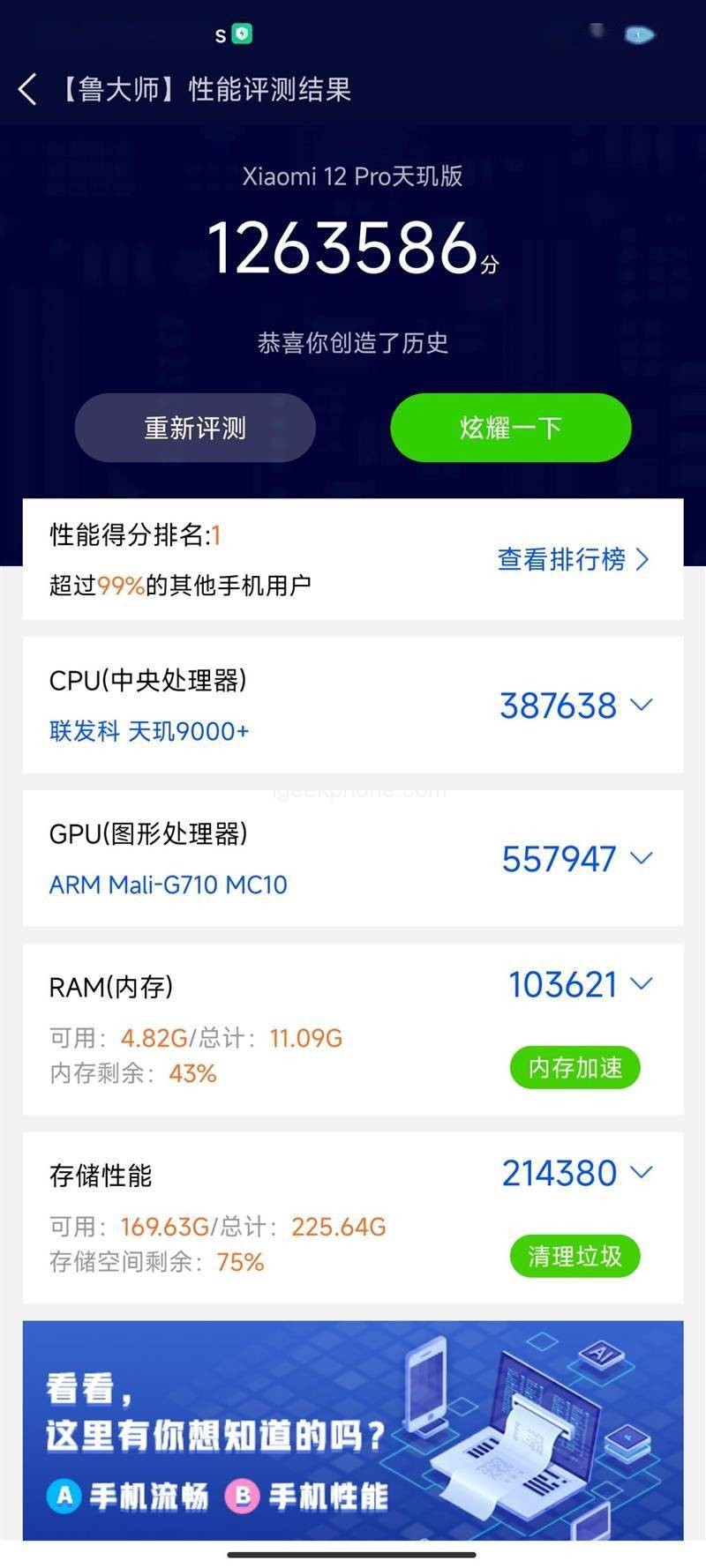
Compared with the Snapdragon 8 regular model, it can lead by about 60,000 points, and it is still 20,000 to 30,000 points compared to the Snapdragon 8+, but it is also within a millimeter.
2. GeekBench 5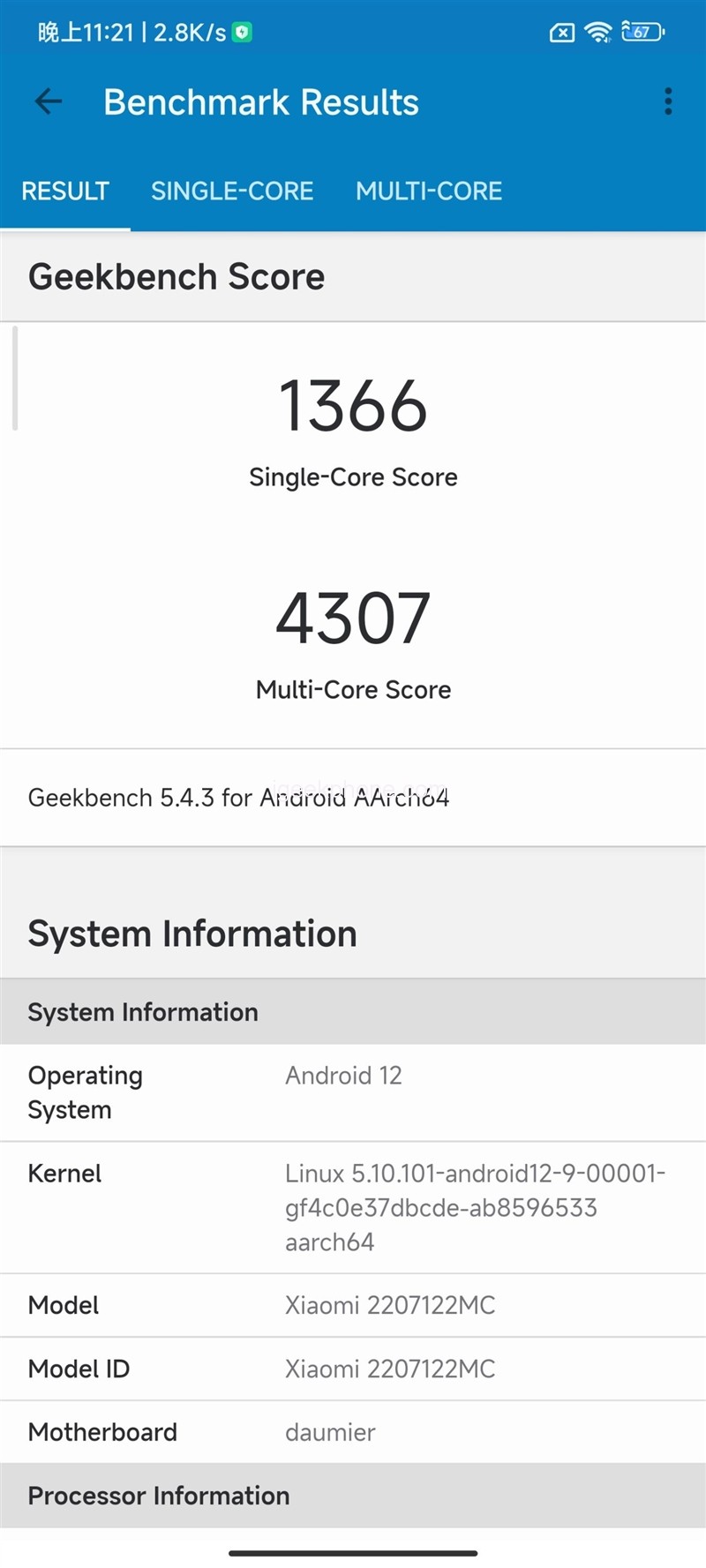
In the Geekbench 5 running score test, the single-core score is 1366 and the multi-core score is 4307. Compared with the previous generation Dimensity 9000, the maximum improvement is about 9%, which is basically in line with the official promotion of 10%.
At the same time, the single-core performance is the same as the Snapdragon 8+, and the multi-core performance can lead by about 5%.
3. GFXBench
In the test results of GFXBench, compared with the previous generation of Dimensity 9000, this generation of Dimensity 9000+ has six projects in Aztec ruins OpenGL, Aztec ruins Vulkan, racing chase, Manhattan 3.1, Manhattan, Tyrannosaurus Rex, ahead by 8.8%, 9.1%, 8.8%, 9.7%, 9.7%, and 9.3%, respectively, which is also almost perfectly in line with the 10% increase in official publicity.
However, compared to the Snapdragon 8/Snapdragon 8+, the Dimensity platform has obvious disadvantages on the GPU, generally lagging by more than 10%.
4. Androbench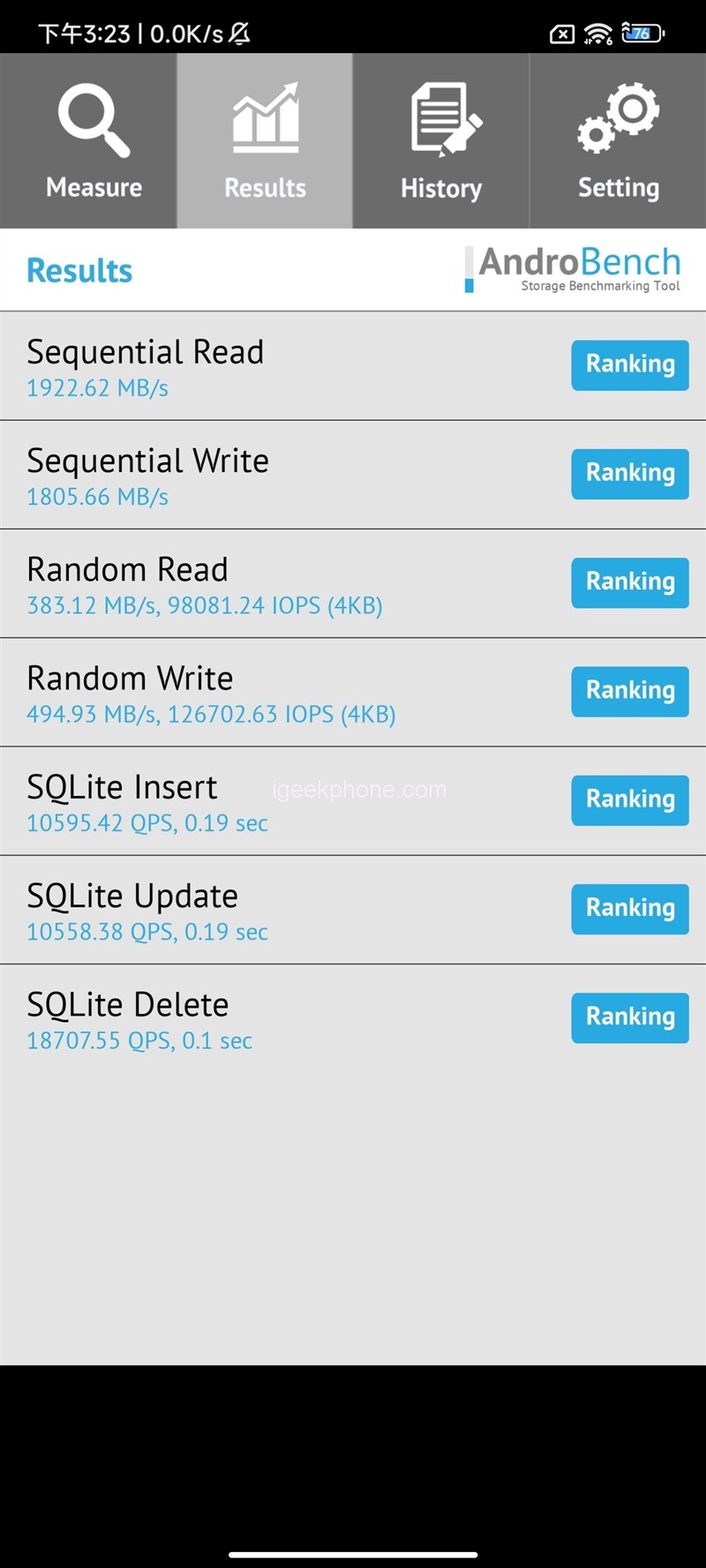
In the continuous reading and writing test, the continuous reading speed reaches 1922.62MB/s, the continuous writing speed reaches 1805.66MB/s, the random reading speed reaches 383.12MB/s, and the random writing speed reaches 494.93MB/s, which is in line with UFS 3.1 Performance.
Game Test
For the game test, we selected three mainstream games, namely “Honor of Kings”, “Peace Elite” and “Genshin Impact”, with the highest frame rate first for testing.
1. King’s Glory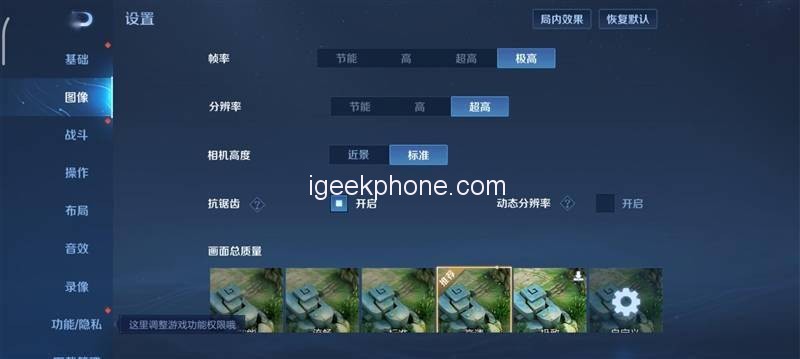
When the Xiaomi Mi 12 Pro Dimensity Edition was in the “Honor of Kings” test, it turned on the highest picture quality at 120 frame rate, played for nearly 10 minutes, and the average frame rate was 118.5FPS, and the overall fluctuation was not large.
When playing the “Honor of Kings” game, the highest temperature on the back of the fuselage is 40.9 ℃, and the highest temperature on the front is 38.9 ℃, the heat is more obvious, but it is not hot.
2. Peace Elite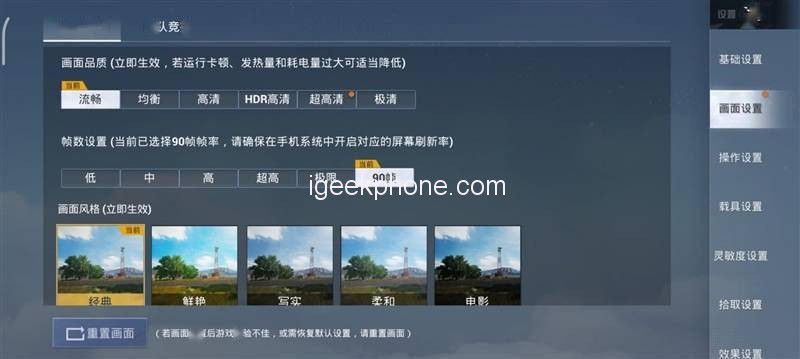
During the game test of “Peace Elite”, the smooth picture quality + up to 90 frames was turned on. After playing for nearly 15 minutes, the game frame rate was completely kept in a straight line, and the average frame rate was 89FPS, which was close to full frame operation.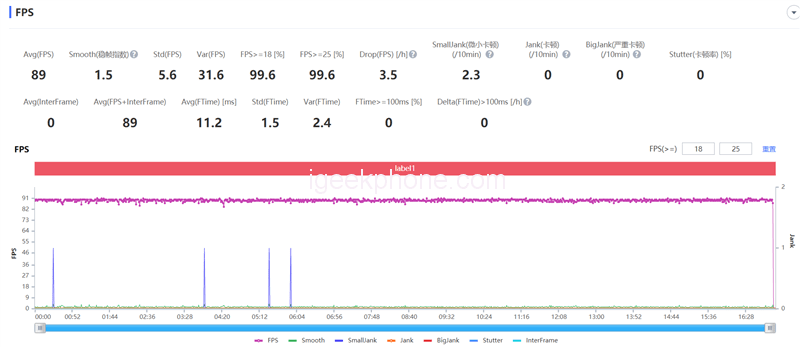
In contrast, the temperatures brought by “Peace Elite” and “Honor of Kings” are not much different, with the highest temperature on the back of the fuselage being 40.8°C and the highest temperature on the front being 40.5°C.
3. Yuanshen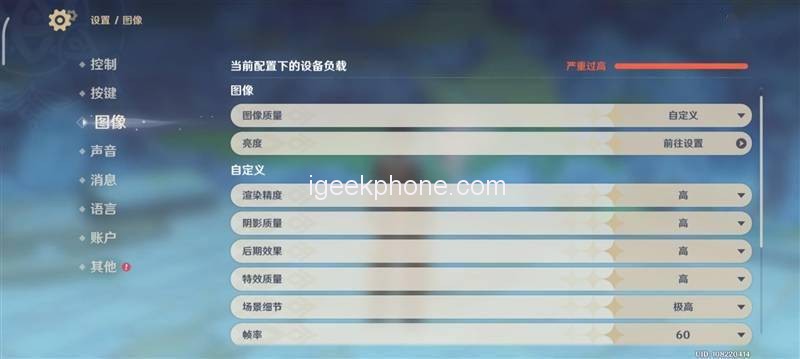
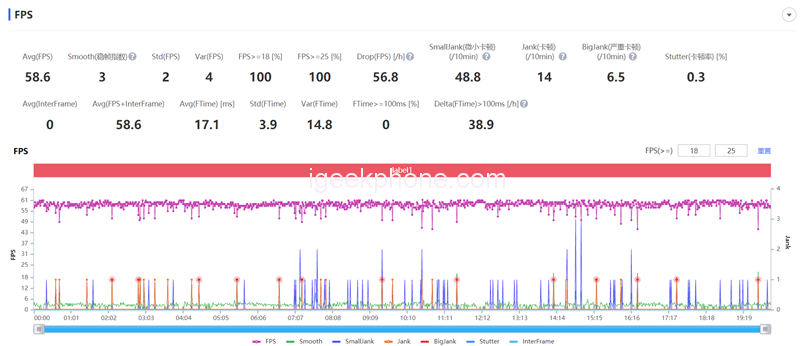
When playing the game “Genshin Impact”, when the highest image quality + 60 frame mode is turned on, after nearly 20 minutes of testing, in the case of fewer monsters or only running pictures, it can be maintained at about 60FPS, and the average frame rate can reach 58.6FPS, which is close to full frame operation, but if the scene is more complicated, Dimensity 9000+ will be a little difficult, especially in the second half.
During the game test, the highest temperature on the back reached 42.5°C, and the highest temperature on the front was 43.7°C. In response to such a high-load and high-quality game, the overall heat of the phone is more obvious.
Cameras
In terms of imaging, the main camera of Xiaomi Mi 12 Pro Dimensity Edition adopts Sony IMX707 CMOS, and the picture output of up to 50 million pixels and the super-sensitive area of 1/1.28 inches can bring stronger resolution and higher latitude. At the same time, the main camera supports four-axis OIS optical anti-shake and full-pixel octa-core focusing, and the anti-shake performance and focus tracking performance in video shooting have been improved accordingly.
The ultra-wide-angle lens of Xiaomi Mi 12 Pro Dimensity Edition uses a 13-megapixel OV13B10 sensor from OmniVision, and there is another 5-megapixel macro lens. Its sensor uses a Samsung S5K3E9, which supports an equivalent focal length of 50mm. Objects within ~7cm can be auto-focused.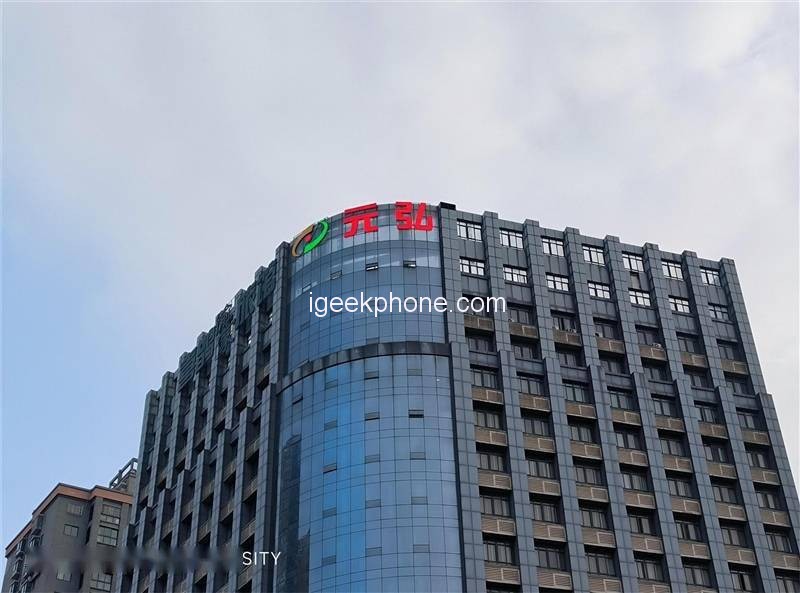
The above is a sample shot of the main camera in daytime automatic mode. Although the weather is cloudy, the details are restored very well, the picture is pure enough, and the latitude performance is very satisfactory, but the colors are not “bright” enough, and sometimes there is a whitish feeling.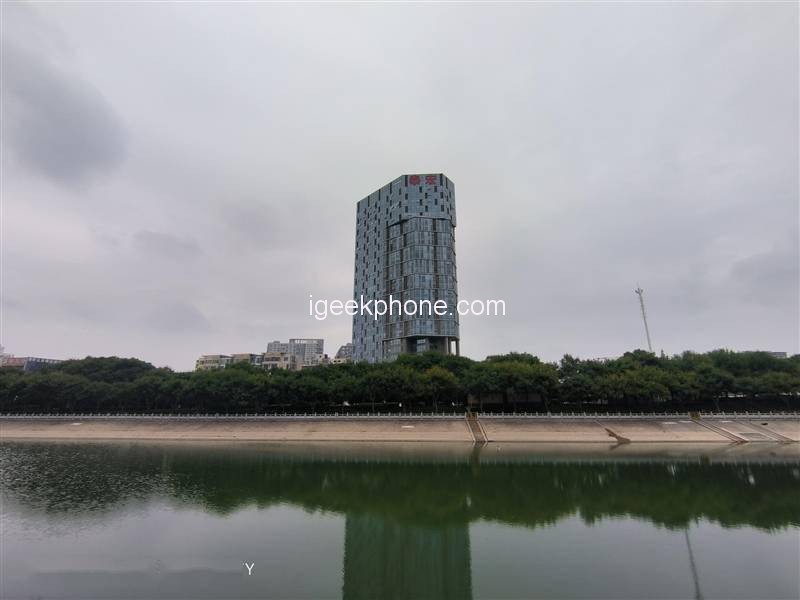
The 1/1.28-inch Sony IMX707 sensor can bring higher incoming light. In the night scene, the resolution of the monochrome scene is relatively good, and there will be no obvious noise, but the suppression of strong light is not enough. Such as small glowing text.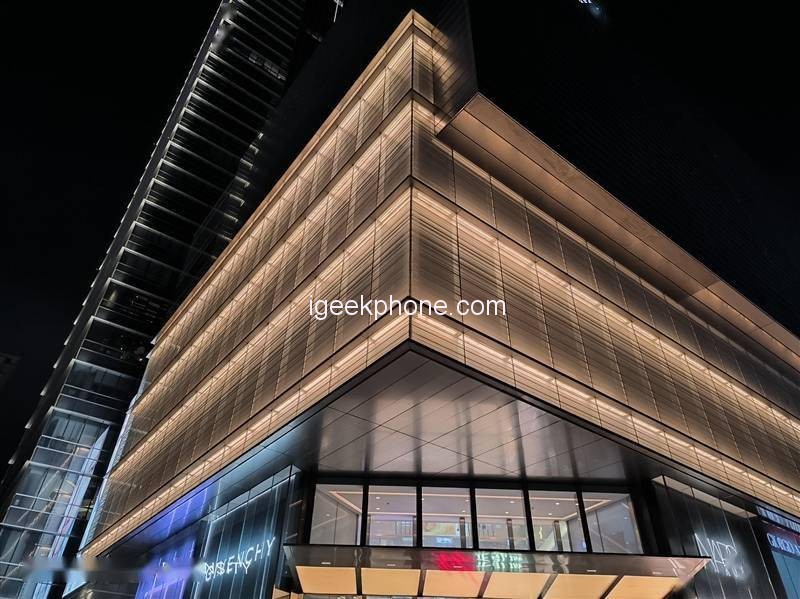
The Sony IMX707 sensor was first launched on the Xiaomi Mi 12 Pro and supports full-pixel dual-core focusing. After the adjustment and optimization of the two generations of Xiaomi models, the overall purity and latitude of the captured images remain at a relatively high-end level. Over time, if we fully tap the optimization potential, the effect will be better.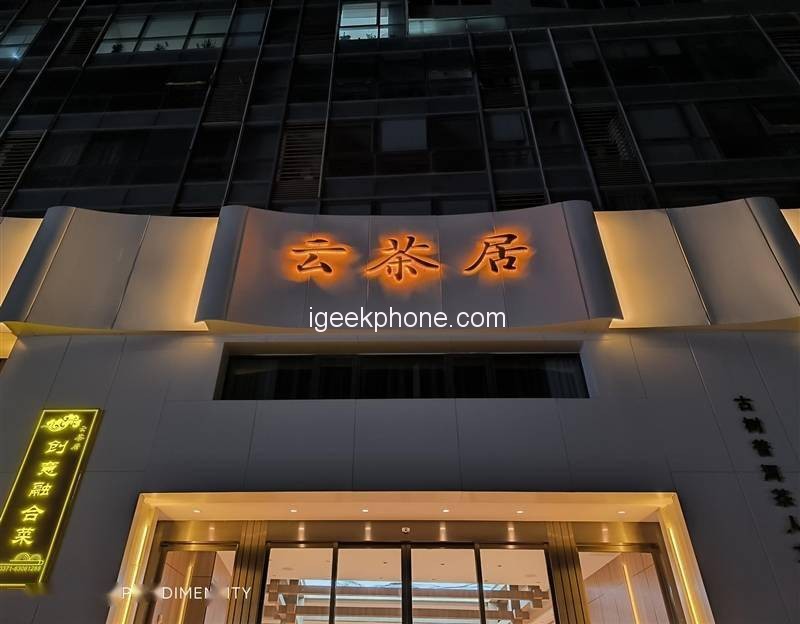
The 13-megapixel ultra-wide-angle lens of the Mi 12 Pro Dimensity Edition has a 12mm focal length and can shoot an ultra-wide frame with 123% uB0. Although it is not as good as the resolution of the main camera, it is completely sufficient to highlight the grandeur and splendor of the picture when dealing with buildings with a wide field of view and crowded scenes.
The Mi 12 Pro Dimensity Edition is equipped with a 5-megapixel macro lens. The details of the picture are rich, and there is no accidental injury in the blurred edge, but the background blur is not natural enough, and there are obvious traces of smearing.
Battery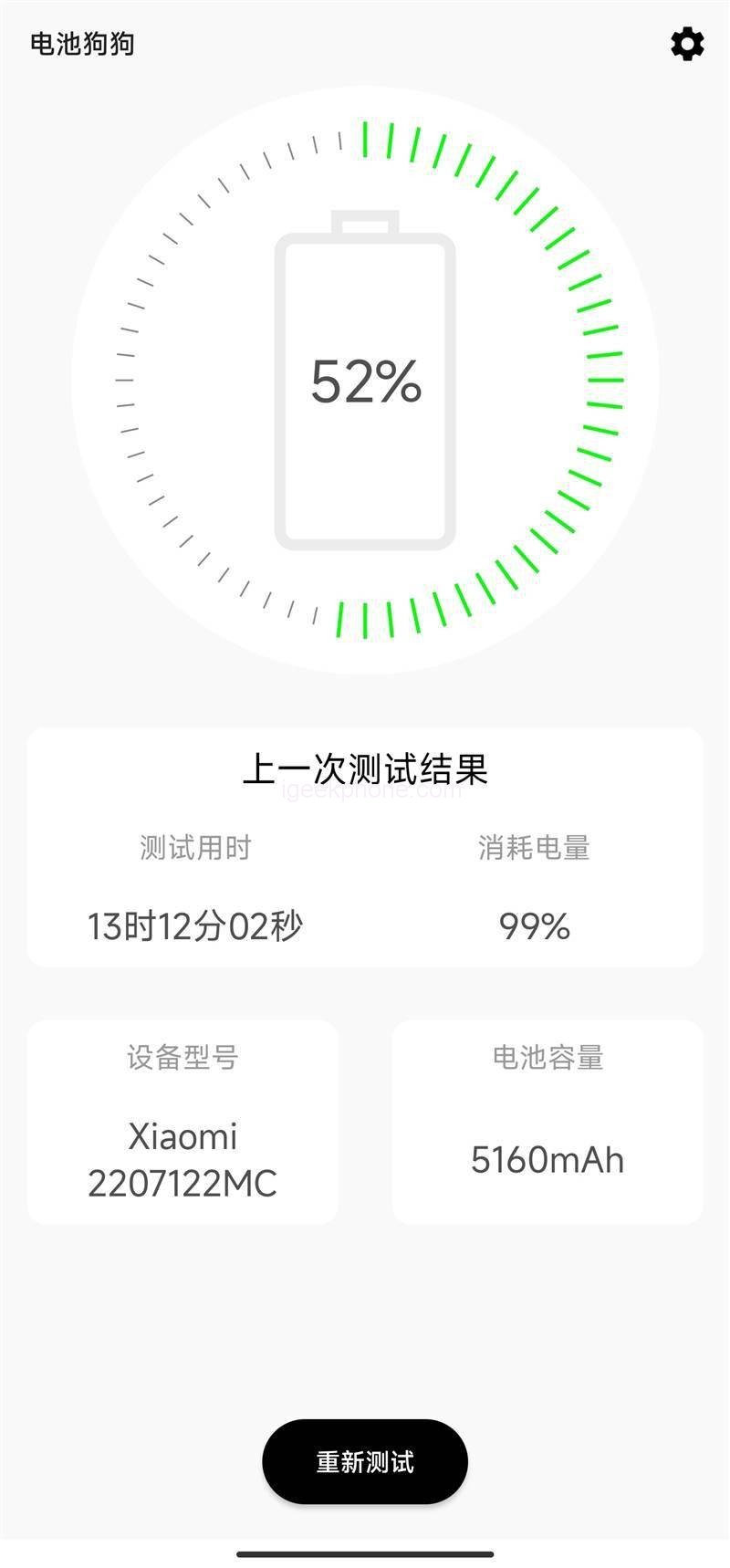
The Mi 12 Pro Dimensity Edition has a built-in 5160mAh battery and supports up to 67W wired fast charging. Measured to charge 13% in 5 minutes, 22% in 10 minutes, 58% in half an hour, and it takes 60 minutes to fully charge.
In addition, Xiaomi Mi 12 Pro Dimensity Edition is equipped with Xiaomi’s self-developed Surging P1 charging chip, which greatly reduces energy loss, improves charging efficiency, and at the same time ensures battery life and prolongs battery life.
Battery Life Test
In terms of battery life, we use a professional battery life test tool – the battery dog produced by Kuai Technology for testing. Setting manual 50% brightness and refresh rate default to intelligent switching, starting from 100% power test to shutting down, Xiaomi Mi 12 Pro Dimensity Edition took a total of 13 hours and 12 minutes, and the overall performance was quite excellent, almost surpassing all devices equipped with Dimensity 9000 chip. This model can get rid of charging anxiety and use easily for a whole day at medium and high intensity.
Verdict
The summary of the Mi 12 Pro Dimensity Edition is as follows:
1. TSMC’s 4nm Dimensity 9000+ beats Samsung’s 4nm Snapdragon 8
The performance and energy efficiency ratio brought by the previous generation Dimensity 9000 is obvious to all. This time, the Dimensity 9000+, which was launched in the Xiaomi Mi 12 Pro Dimensity Edition, has taken a new level of comprehensive performance.
The addition of Dimensity 9000+ makes Xiaomi 12 Pro have no shortcomings in performance and power consumption. It can be said that it has become one of the strongest SoCs in Android, and its comprehensive strength is basically at the same level as Snapdragon 8. Both single-core and multi-core have even surpassed the Snapdragon 8+, but the GPU still lacks some heat.
At the same time, the high energy efficiency combined with the large-capacity battery of 5160mAh has a very good performance in terms of battery life, and the performance of more than 13 hours is also on the fingertips in the mobile phone circle.
For now, the Dimensity 9000+ can be said to be the flagship processor platform with the best energy efficiency.
2. The game is stable and the temperature is lower
In the game, both “Honor of Kings” and “Peace Elite” can run smoothly in the form of a high frame rate + low fever, while for “Genshin Impact” with a higher load, the average frame rate can be maintained at about 58 frames, and the overall The performance is relatively smooth, and there is no obvious frame drop phenomenon.
In terms of temperature control, in the 20-minute test of “Genshin Impact”, the highest temperature was only 43.7 degrees Celsius, so there is no obvious hot feeling during normal games, and the Snapdragon 8 mobile phone can even reach a maximum of 45 degrees Celsius.
3. The main camera of the Sony IMX707 performs well during the day, but the effect at night is not good
In terms of images, the Sony IMX707 main camera can restore scene details well in daytime scenes with a 1/1.28-inch outsole photosensitive unit. It’s just that the overall color gives a faint and hazy feeling, which is not suitable for the “color party”. In addition, the ultra-wide-angle color reproduction is also in place, and there is no obvious distortion at the edges.
In terms of night scenes, the control of strong light scenes is not particularly in place, and it needs to be optimized, while the control of monochrome scenes is still excellent, and there will be no obvious noise in the dark sky.
4. The charging speed is quite satisfactory
In terms of charging, the 67W wired fast charging power is not high, coupled with the decentralization of Xiaomi’s self-developed Surging P1 charging chip, the Xiaomi Mi 12 Pro Dimensity Edition will not have obvious heating during charging, which indirectly improves the charging efficiency. It’s just that the speed is significantly slower, and it takes 1 hour to fully charge.
Also, unfortunately, wireless charging and reverse wireless charging are gone.
5. Top Samsung screen with LTPO2.0 display effect and power consumption control
The screen inherits the Samsung E5 luminous material, which brings high contrast and high brightness screen, allowing users to see the phone screen clearly in direct sunlight.
LTPO2.0 adaptive refresh rate, 2K resolution, and native 10bit color depth not only ensure the clarity and color reproduction of the mobile phone screen but also have excellent performance in power consumption control.
With a 6.73-inch large screen and a slim body, the whole machine achieves a weight of 201g, which does not feel too heavy in the hand.
In general, the Xiaomi Mi 12 Pro Dimensity Edition makes the debut of the Dimensity 9000+ very amazing. The performance and energy efficiency are tightly controlled by MediaTek. You don’t have to worry about hot hands in summer. The screen display effect, but the imaging ability does not seem to have released all the power of the wild, there is still a lot of room for improvement in night scenes, macros, etc., and I look forward to the follow-up firmware update and improvement.
Xiaomi Mi 12 Pro Dimensity Edition, as Lei Jun’s “performance explosion”, has better performance and battery life than Xiaomi Mi 12 Pro. It has the same high-quality screen, although there is some shrinkage in photography, fast charging, and speakers, The starting price has also increased from 4,699 yuan to 3,999 yuan, which is very suitable for users who want both a cool flagship experience and cost-effectiveness this summer.










